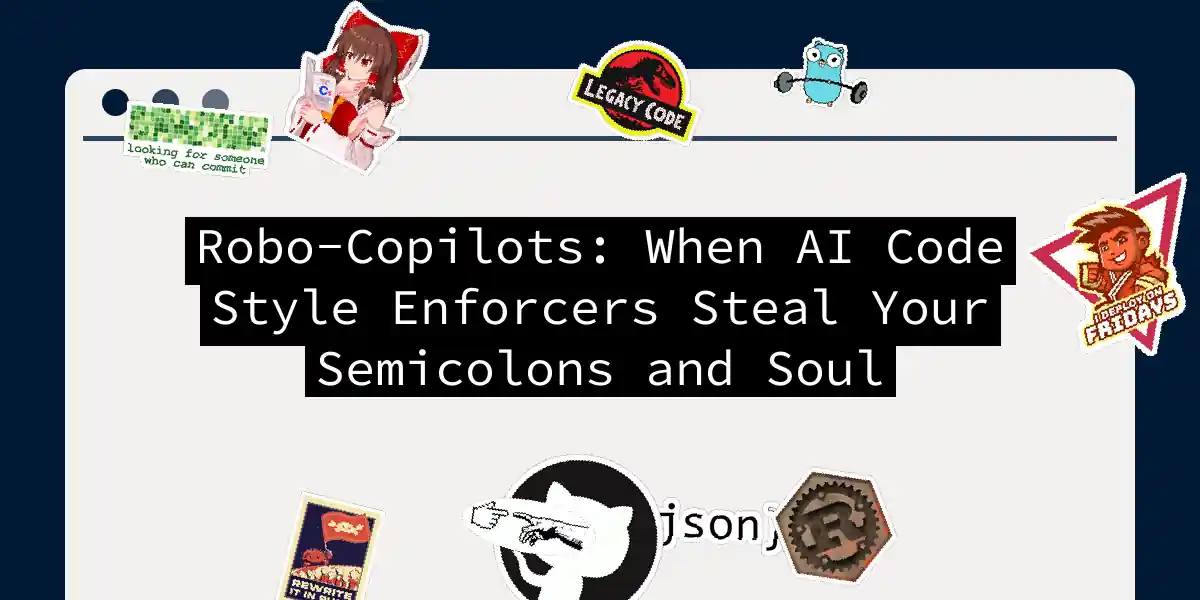Picture this: you’ve just written the most elegant Python function of your career. It’s lean, mean, and does something with pandas DataFrames that would make Wes McKinney blush. You commit with pride… only to get slapped with 27 style violations from your new AI overlord. Suddenly, your masterpiece looks like a Jackson Pollock painting made of PEP8 errors. Welcome to the age of AI-powered code style enforcement.
The Rise of the Lintatron 9000
Modern AI style enforcers aren’t your grandpa’s linters. Today’s tools combine:
These systems don’t just check indentation - they understand context. I once watched in horror as an AI refactored my perfect one-liner into a 10-line monstrosity “for better readability.” The betrayal!
Hands-On: Setting Up Your Digital Drill Sergeant
Let’s get practical. Here’s how to implement AI style enforcement without crushing team morale:
- Choose your weapon (I mean tool):
# For Python teams pip install robotic-pep8-enforcer==2.0.42 - Configure your
oppressionrules:{ "max_line_length": 88, "forbidden_patterns": ["lambda: x", "import *"], "allowed_quirks": { "creative_naming": 3, "experimental_syntax": 1 } } - Integrate with your CI/CD:
# .github/workflows/style_cop.yml - name: AI Style Enforcement uses: RoboCopilot/AI-Linter@v3 with: snark_level: 8 # 1-10, default = 5 mercy_rules: "no_fire_to_kittens = true"
Pro tip: Set snark_level above 7 only if your team enjoys passive-aggressive error messages like “This variable name is so bad it made my GPU cry.”
The Creativity Conundrum
While AI enforcers excel at catching var i = "Hello World"; in JavaScript, they sometimes miss the forest for the trees. I recently engineered this beautiful SQL optimization:
SELECT
(SELECT value FROM params WHERE key = 'magic_number') AS alchemy_coeff,
COUNT(*) FILTER (WHERE entropy > 0.9) AS chaos_score
FROM universe
The AI wanted to “fix” it by:
SELECT
params.value AS magic_number_renamed,
COUNT(CASE WHEN entropy > 0.9 THEN 1 END) AS chaos_score_renamed
FROM universe
CROSS JOIN params
WHERE params.key = 'magic_number'
Yes, it’s technically more standard. But at what cost? My artistic SQL license was revoked!
When AI Gets It Wrong: Horror Stories
- The Case of the Helpful Saboteur
# Human-written
df.query('temp > 32').groupby('city').agg({'sales': 'mad'})
# AI "improvement"
df[df['temp'] > 32].groupby(by='city').aggregate(
aggregated_sales=('sales', 'median_absolute_deviation')
)
The AI “fixed” the perfectly valid pandas code… by making it 40% longer and 300% more unreadable. Thanks, I hate it.
2. The Great Bracket Purge of 2024
One team’s AI decided all JavaScript arrow functions needed explicit returns. Next sprint planning sounded like an AA meeting: “Hi, I’m Dev 42 and I can’t write concise callbacks anymore.”
Finding Balance: Pro Tips
- Custom Rule Sandboxes
Create “creativity zones” where developers can bypass certain rules:
# .creativity-zones.yml
experimental_features:
- file_glob: "src/experiments/*.py"
allowed:
- weird_decorators
- quantum_variable_names
# Because sometimes "spooky_action" IS the perfect var name
- The 80/20 Compromise
Let AI handle the mechanical 80% of style issues, leaving the 20% creative flourishes to humans. Your codebase isn’t a Dickens novel - a few sentence fragments won’t kill anyone. - Weekly Revolt Sessions
Set up afree_coding_fridaybranch where:
- All style rules are disabled
- Variable names can be Pokémon references
- Any AI enforcement results in immediate repo self-destruction
The Philosophical Angle: Tool vs. Collaborator
Like a overeager intern who alphabetizes your spice rack, AI enforcers need careful supervision. The key is remembering:
As I tell my team: “If the AI never rejects your code, you’re either perfect or predictable. Neither is good for business.”
Your Move, Meatbags
At the end of the day, AI style tools are like garlic in code pasta:
- Too little: Code smells
- Too much: Everyone avoids your PRs
- Just right: Pure magic(ally maintainable code) The choice isn’t between creativity and quality - it’s about finding where your team’s secret sauce lives. Now if you’ll excuse me, I need to go argue with a bot about whether “const fnord = 42” constitutes adequate documentation. Got your own AI enforcement horror stories? Share them in the comments - we’ll start a support group. First rule of Lint Club: You don’t talk about lambda expressions.
